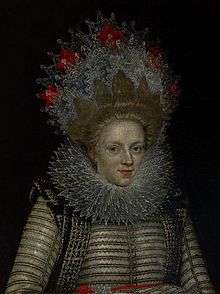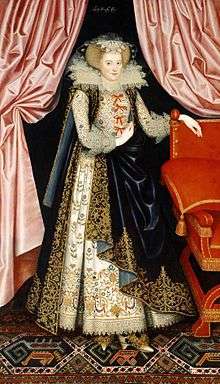Elizabeth Cary, Viscountess Falkland
| Lady Falkland | |
|---|---|
 by Paul van Somer c. 1620 | |
| Born |
1585 Burford Priory, Oxfordshire, England |
| Died |
1639 (aged 53–54) London, England |
| Occupation | Poet, translator, dramatist |
| Nationality | English |
| Period | 1598–1639 |
| Notable works | The Tragedy of Mariam |
Elizabeth Cary, Viscountess Falkland (née Tanfield; 1585–1639), was an English poet, dramatist, translator, and historian. She is the first woman known to have written and published an original play in English (The Tragedy of Mariam). From an early age, she was recognized as an accomplished scholar by contemporary writers.
Early life
Elizabeth Tanfield was born in 1585 or 1586 at Burford Priory in Oxfordshire, the only child of Sir Lawrence Tanfield and his wife Elizabeth Symondes of Norfolk.[1] Her father was a lawyer, who eventually became a judge and Lord Chief Baron of the Exchequer. Her parents were very supportive of their daughter's love for reading and learning, which was so great that her mother forbade the servants from giving Elizabeth candles to read by at night.
Elizabeth's parents employed a French instructor for her when she was five years old. Five weeks later, she was speaking fluently. After excelling in French, she insisted on learning Spanish, Italian, Latin, Hebrew, and Transylvanian on her own, without an instructor.[2] Her accomplishment as a scholar was stressed by Michael Drayton[3] and by John Davies[4] in works they dedicated to her.
At the age of fifteen, her father arranged her marriage to Sir Henry Cary, later made Viscount Falkland, who married her because she was an heiress. When she finally moved into her husband's home, her mother-in-law informed Cary that she was forbidden to read, so she instead chose to write poetry in her spare time.

It was not until seven years after they were married that Lord and Lady Falkland had children; they would go on to have a total of eleven: Catherine (1609–1625), Lucius (1610–1643; became the second Viscount Falkland), Lorenzo (1613–1642), Anne (c.1614–1671),[5] Edward (1616–1616), Elizabeth (1617–1683), Lucy (1619–1650), Victoria (1620–1692), Mary (1621–1693), Henry (1622–?), and Patrick (1623–1657).
At the age of twenty, Cary began doubting her Protestant upbringing. Her brother-in-law helped her find Catholicism by telling her stories of his travels and recommending books for her to read. In 1622 Sir Henry Cary was appointed Lord Deputy of Ireland and Elizabeth Cary joined him in Dublin. There she socialized with prominent local Catholics and patronized Catholic writers. This may have contributed to her conversion to Catholicism.[1]
Five of her children (Anne, Elizabeth, Lucy, Mary, and Henry) joined the church in their lifetime.
Later years
By 1625 Elizabeth Cary was disinherited by her father just before he died for using part of her jointure to meet expenses. The money that was initially meant for her had gone instead to her eldest son, Lucius, who was strapped with debt. The disinheritance came after she had tried to fiscally boost her husband, who had been struggling to pay for his lands in Ireland. This same year she returned from Ireland and Cary publicly announced her conversion to Catholicism in 1626, which resulted in her husband's attempted and unsuccessful divorce, although he did deny her access to their children. Despite several orders of the Privy Council, he refused her a maintenance in an apparent effort to force her to recant. Her motivations for conversion are not thought to have stemmed from proselytizers of the religion, but more from her own personal reflections and experiences. One can say that her process was very much organic and natural.
Her husband died in 1633, and she sought to regain custody of her children. She was questioned in the Star Chamber for kidnapping her sons (she had previously, and more easily, gained custody of her daughters), but although she was threatened with imprisonment there is no record of any punishment. In 1634 Elizabeth, Mary, Lucy and Anne Cary were converted to the Catholic faith by John Fursdon who was their mother's confessor. Edward Barrett, Lord Barrett reported this to King Charles I and he agreed for the four girls to be removed from their mother's house and taken to Great Tew.[5] Great Tew had been inherited by her son Lucius Cary who was then Viscount Falkland.[6]
Elizabeth Cary was an avid and secretive reader from a young age, in part due to her attempt to understand Protestantism. Part of her understanding of religious texts was directly influenced by her understanding of literature. Once fully in-step with Catholicism, she dedicated herself to guiding her children towards the Roman Catholic Church by "opening channels for God and paths for her children, but making sure she didn't block the road by loitering in the middle of it herself".[7] Her eldest daughter, Catherine, reported an apparition of the Virgin Mary while on her deathbed. This apparent sighting deeply moved Cary and only furthered her mission to convert all of her children, as Catherine had still been a Protestant at the time of her death. By the end of Cary's life her mission had become partially successful; four of her daughters went on to become Benedictine nuns, and one of her sons joined the priesthood.[5]
In 1639, Elizabeth Cary, Lady Falkland died in London, poor, but rich in her generosity, talent and strength. She is buried in Henrietta Maria's Chapel in Somerset House.[8]
Writing
According to the biography written by her daughter, Elizabeth Cary believed that poetry was the highest literary form. Many of her poems have been lost over time but her dedication to poetry is evident throughout her plays. Her first (or possibly her second[9]) play The Tragedy of Mariam, the Fair Queen of Jewry (1613) was written in iambic pentameter with the use of couplets throughout as well as the use of irony. The change in pattern and rhyme scheme show multiple sonnets throughout the play, and the irony is a traditional element of the sonnet. The Tragedy of Mariam was progressive for its time because it was the first English play to be written by a woman.[10] Her social commentary discussed divorce and female agency, which was innovative for the time. The play discusses revenge, scheming, and plotting as core elements which all aid in her critique about patriarchal tyranny.
Elizabeth Cary then wrote The History of the Life, Reign, and Death of Edward II (1626/1627) which was a political fable based on historical events.[10] The History was not published until 1680, but Falkland had written it much earlier. The text uses the story of King Edward II and his powerful favorites Gaveston and Spencer as an analogy for King Charles, who in the 1620s was in conflict with Parliament about the power granted to the Duke of Buckingham. Cary was in constant contact with Buckingham and his family and writing The History may have been her way to cope with having to constantly rely on Buckingham and his family. She focuses on the idea of favouritism much throughout the piece and how it can lead to disastrous outcomes. Other than the Tragedy of Mariam and the History, much of Falkland’s original work has been lost, including most of her poetry.[10]
Works
| Library resources about Elizabeth Cary, Viscountess Falkland |
| By Elizabeth Cary, Viscountess Falkland |
|---|
- The mirror of the world, a translation of Abraham Ortelius's Le mirroir du monde (1598)
- The Tragedy of Mariam, the Fair Queen of Jewry (pub. 1613)
- Reply of the most Illustrious Cardinal of Perron (1630)
- The History of the Life, Reign and Death of Edward II, or The History of the most Unfortunate Prince, King Edward II (pub. 1680)
References
- 1 2 1586-1639., Cary, Elizabeth, Lady, 1585 or (2012). The tragedy of Mariam, the fair queen of Jewry. Wray, Ramona, 1971- (New ed.). London: Arden Shakespeare. ISBN 9781904271598. OCLC 798312313.
- ↑ Cary, Elizabeth, Barry Weller, and Margaret W. Ferguson. The Tragedy of Mariam, the Fair Queen of Jewry / Her Life / by One of Her Daughters; Edited by Barry Weller and Margaret W. Ferguson. Berkeley: University of California, 1994. Print.
- ↑ Drayton, Michael (1597). England's Heroical Epistles, written in imitation of the style and manner of Ovid's Epistles with annotations of the chronicle history. London: S. Smethwick. pp. 43v.
- ↑ Davies, John (1612). The Muses Sacrifice. London: T.S. for George Norton. pp. 3v.
- 1 2 3 Heather Wolfe, ‘Cary, Anne (bap. 1614, d. 1671)’, Oxford Dictionary of National Biography, Oxford University Press, May 2014 accessed 7 April 2017
- ↑ Lucius Cary, Viscount Falkland, BCW project, Retrieved 7 April 2017
- ↑ Freeman, Peter. "The Unhidden Faith of Lady Falkland." Crisis Magazine, a Voice for the Faithful Catholic Laity. Crisis Magazine, 23 June 2011. Web.
- ↑ "Elizabeth Cary, Viscountess Falkland, writer, Translator & Catholic Recusant." The Twickenham Museum, the history centre for Twickenham Whitton, Teddington, and the Hamptons. The Twickenham Museum , n.d. Web. 12 March 2014.
- ↑ Simon Barker, Hilary Hinds (eds.), The Routledge Anthology of Renaissance Drama, Routledge, Abingdon (2003), p. 194: "Cary seems to have written an earlier play, now lost, set in Sicily and dedicated to her husband (hence the reference to 'my first' in l. 13 [of the dedication to Mariam]".
- 1 2 3 Hodgson-Wright, Stephanie. "Cary, Elizabeth, Viscountess Falkland (1585–1639)." Oxford Dictionary of National Biography. Ed. H. C. G. Matthew and Brian Harrison. Oxford: OUP, 2004. 15 November 2006.
Further reading
- Blain, Virginia, et al., eds. "Cary, Anne (c.1615–71) or Mary (c.1622–93)"; "Falkland, Elizabeth Cary." The Feminist Companion to Literature in English. New Haven and London: Yale UP, 1990. 186, 354.
- Buck, Claire, ed. "Cary, Elizabeth Tanfield, Lady Falkland." The Bloomsbury Guide to Women's Literature. Prentice Hall, 1992; p. 397.
- Greer, Germaine, et al., eds. "Elizabeth Cary, Viscountess Falkland." Kissing the Rod: An Anthology of Seventeenth-Century Women's Verse. Farrar Straus Giroux, 1988; pp. 54–55.

- Hodgson-Wright, Stephanie (May 2014) [2004]. "Cary, Elizabeth, Viscountess Falkland (1585–1639)". Oxford Dictionary of National Biography (online ed.). Oxford University Press. doi:10.1093/ref:odnb/4835. (Subscription or UK public library membership required.)
- Shapiro, Arlene Iris, "Elizabeth Cary: Her Life, Letters, And Art, Dissertation (Ph.D.)-State University of New York at Stony Brook, 1984.
- Verzella, Massimo, “Hid as worthless rite”. Scrittura femminile nell’Inghilterra di re Giacomo: Elizabeth Cary e Mary Wroth, Roma, Aracne, 2007.
- Verzella, Massimo, “The Renaissance Englishwoman’s Entry into Print: Authorizing Strategies”, The Atlantic Critical Review, III, 3 (July–September 2004), pp. 1–19;
- Cary, Elizabeth, Barry Weller, and Margaret W. Ferguson. The Tragedy of Mariam, the Fair Queen of Jewry / Her Life / by One of Her Daughters; Edited by Barry Weller and Margaret W. Ferguson. Berkeley: University of California, 1994. Print.
- "Elizabeth Cary, Viscountess Falkland, Writer, Translator & Catholic Recusant." The Twickenham Museum, the history centre for Twickenham Whitton, Teddington, and the Hamptons. The Twickenham Museum, n.d. Web. 12 March 2014.
- F., E., Henry Cary, and Edward Fannant. The History of the Life, Reign, and Death of Edward II., King of England, with the Rise and Fall of His Great Favourites, Gaveston and the Spencers. Written by E.F. in the Year 1627, Etc. London: J.C. for Charles Harper, 1680. Print.
- Freeman, Peter. "The Unhidden Faith of Lady Falkland." Crisis Magazine, a Voice for the Faithful Catholic Laity. Crisis Magazine, 23 June 2011. Web. 12 March 2014
- Wolfe, Heather. The Literary Career and Legacy of Elizabeth Cary, 1613–1680. New York: Palgrave Macmillan, 2006. Ebook.
External links
| Wikimedia Commons has media related to Elizabeth Cary, Viscountess Falkland. |
- Works by or about Elizabeth Cary, Viscountess Falkland at Internet Archive
- Works by Elizabeth Cary, Viscountess Falkland at LibriVox (public domain audiobooks)
